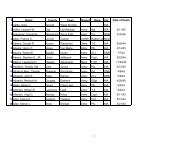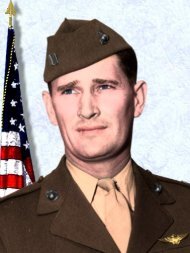master sergeant woodrow wilson keeble medal of honor ceremony
master sergeant woodrow wilson keeble medal of honor ceremony
master sergeant woodrow wilson keeble medal of honor ceremony
- No tags were found...
You also want an ePaper? Increase the reach of your titles
YUMPU automatically turns print PDFs into web optimized ePapers that Google loves.
Congressional<br />
Medal <strong>of</strong> Honor Recipient<br />
MASTER SERGEANT<br />
WOODROW WILSON KEEBLE<br />
MEDAL OF HONOR<br />
CEREMONY<br />
March 17, 2008 ~ 12:00 Noon<br />
Chambers <strong>of</strong> the<br />
South Dakota House <strong>of</strong> Representatives<br />
South Dakota State Capitol
The President <strong>of</strong> the United States <strong>of</strong> America,<br />
authorized by Act <strong>of</strong> Congress, March 3, 2008,<br />
has awarded in the name <strong>of</strong> Congress<br />
the Medal <strong>of</strong> Honor to:<br />
MASTER SERGEANT WOODROW W. KEEBLE<br />
UNITED STATES ARMY<br />
Citation<br />
The President <strong>of</strong> the United States <strong>of</strong> America, in the name <strong>of</strong> Congress,<br />
takes pride in presenting the Medal <strong>of</strong> Honor to Master Sergeant Woodrow<br />
W. Keeble, United States Army, for conspicuous gallantry and intrepidity, at<br />
the risk <strong>of</strong> his life, above and beyond the call <strong>of</strong> duty:<br />
In action with an armed enemy near Sangsan-ni, Korea, on 20 October,<br />
1951. On that day, Master Sergeant Keeble was an acting platoon leader for<br />
the support platoon in Company G, 19th Infantry, in the attack on Hill 765,<br />
a steep and rugged position that was well defended by the enemy. Leading<br />
the support platoon, Master Sergeant Keeble saw that the attacking elements<br />
had become pinned down on the slope by heavy enemy fire from three wellfortified<br />
and strategically placed enemy positions. With complete disregard<br />
for his personal safety, Master Sergeant Keeble dashed forward and joined<br />
the pinned-down platoon. Then, hugging the ground, Master Sergeant<br />
Keeble crawled forward alone until he was in close proximity to one <strong>of</strong> the<br />
hostile machine-gun emplacements. Ignoring the heavy fire that the crew<br />
trained on him, Master Sergeant Keeble activated a grenade and threw it with<br />
great accuracy, successfully destroying the position. Continuing his one-man<br />
assault, he moved to the second enemy position and destroyed it with<br />
another grenade. Despite the fact that the enemy troops were now directing<br />
their firepower against him and unleashing a shower <strong>of</strong> grenades in a frantic<br />
attempt to stop his advance, he moved forward against the third hostile<br />
emplacement, and skillfully neutralized the remaining enemy position. As his<br />
comrades moved forward to join him, Master Sergeant Keeble continued to<br />
direct accurate fire against nearby trenches, inflicting heavy casualties on the<br />
enemy. Inspired by his courage, Company G successfully moved forward and<br />
seized its important objective. The extraordinary courage, selfless service,<br />
and devotion to duty displayed that day by Master Sergeant Keeble was an<br />
inspiration to all around him and reflected great credit upon himself, his unit,<br />
and the United States Army.
MASTER SERGEANT WOODROW WILSON KEEBLE<br />
MEDAL OF HONOR CEREMONY<br />
PROGRAM SCHEDULE<br />
Governor M. Michael Rounds<br />
and the 83 rd Session<br />
<strong>of</strong> the South Dakota State Legislature<br />
Joint Session<br />
12:00 Noon ~ Monday, March 17, 2008<br />
Chambers <strong>of</strong> the South Dakota House <strong>of</strong> Representatives<br />
State Capitol~ Pierre, South Dakota<br />
12:00 PM House and Senate Convene in Joint Session<br />
Lieutenant Governor Dennis Daugaard, Presiding<br />
12:02 PM Motion to Escort Honored Guests to Rostrum<br />
12:04 PM Entrance <strong>of</strong> Dignitaries<br />
Governor M. Michael Rounds<br />
Entrance <strong>of</strong> Celebrants<br />
Sisseton-Wahpeton Vietnam Veterans – Kit Fox Society<br />
Duane “Doc” Wanna Greg Maetaes<br />
Joe William Dave Roberson<br />
Dave Flute John Two Stars<br />
Dayton Seaboy Ed Williams<br />
Gerald Thompson Darrell White<br />
Lincoln DeMarrias<br />
Entrance <strong>of</strong> Keeble Family<br />
12:08 PM National Anthem<br />
Anthony Hunt – Pierre Riggs High School Senior<br />
12:11 PM Dakota Prayer<br />
Joe Williams – Sisseton-Wahpeton Oyate<br />
12:16 PM Reading <strong>of</strong> the Proclamation and Brief Remarks<br />
Governor M. Michael Rounds<br />
12:20 PM Reading <strong>of</strong> the Concurrent Legislative Resolution<br />
Tim Rave, Speaker Pro Tempore<br />
12:24 PM Dakota Warrior Song<br />
Dayton Seaboy - David Flute<br />
12:30 PM Motion to Dissolve Joint Session <strong>of</strong> the Legislature
MASTER SERGEANT WOODROW WILSON KEEBLE<br />
Woodrow Wilson Keeble was born in Waubay, South Dakota, to Isaac and Nancy<br />
(Shaker) Keeble on May 16, 1917. While still very young, he moved to Wahpeton, North<br />
Dakota, where his mother worked at the Wahpeton Indian School (now called Circle <strong>of</strong><br />
Nations School). Woodrow excelled in athletics, especially baseball, and pitched the<br />
Wahpeton amateur team to ten straight victories. He was being recruited by the Chicago<br />
White Sox when his Army National Guard unit was called up to serve in World War II.<br />
In World War II, Keeble served with I Company <strong>of</strong> the famed North Dakota 164th<br />
Infantry Regiment. After initial training in Louisiana, the regiment deployed to Australia in<br />
preparation for operations in the Pacific Theater. Keeble's unit was assigned to the Americal<br />
Division (<strong>of</strong>ficially the 23th Infantry Division). The 164th landed on Guadalcanal on<br />
October 13, 1942, to help the battered First Marine Division clear the South Pacific island <strong>of</strong><br />
Japanese. Keeble's regiment <strong>of</strong> Dakotans was the first United States Army unit to conduct<br />
an <strong>of</strong>fensive operation against the enemy in any theater.<br />
During these battles, Keeble's reputation for bravery and skill grew. Nearly a head taller<br />
than most <strong>of</strong> his fellow soldiers, he was an expert with the Browning Automatic Rifle (BAR).<br />
His other great weapon was his pitching arm, which he used to hurl hand grenades with<br />
deadly accuracy. James Fenelon, a member <strong>of</strong> the Standing Rock Sioux Tribe <strong>of</strong> North and<br />
South Dakota who fought with Keeble on Guadalcanal, once remarked that “The safest<br />
place to be was right next to Woody.”<br />
After the battles on Guadalcanal, Keeble and the rest <strong>of</strong> the regiment participated in<br />
combat campaigns on the islands <strong>of</strong> Bougainville, Leyte, Cebu, and Mindanao. Following the<br />
Japanese surrender, the entire Americal Division landed in Japan and took part in the<br />
occupation <strong>of</strong> the Yokohama region.<br />
After the war, Keeble returned to Wahpeton and worked at the Wahpeton Indian<br />
School. In 1947, Woodrow Wilson Keeble married Nettie Abigail Owen-Robertson.<br />
The 164th Infantry Regiment was reactivated in 1951 during the Korean War; they<br />
trained at Camp Rucker, Alabama. When Keeble's commanding <strong>of</strong>ficer had to select several<br />
<strong>sergeant</strong>s for deployment to the front lines, he decided to have his men draw straws. Keeble<br />
volunteered instead. Asked why, Keeble said, “Somebody has to teach these kids how to<br />
fight.”<br />
Keeble, described as a gentle giant by his friends, was a ferocious warrior in battle, as<br />
evidenced by his heroic actions during Operation Nomad-Polar. Official records confirm<br />
Keeble was initially wounded on October 15, and then again on October 17, 18, and 20 - for<br />
which he received only one Purple Heart. For his bravery on the 18th, he was awarded a<br />
Silver Star. His heroism on the 20th made Keeble a legend - and 57 years later resulted in his<br />
posthumous Medal <strong>of</strong> Honor.<br />
His bravery in the face <strong>of</strong> enemy fire was so remarkable that a recommendation that he<br />
receive the Medal <strong>of</strong> Honor was twice submitted. In both cases, the recommendation was<br />
lost. When Keeble's men endeavored to submit the recommendation a third time, <strong>of</strong>ficials<br />
informed them they were too late; the 24th Division had reached its quota <strong>of</strong> Medal <strong>of</strong><br />
Honor recipients. After reconsideration, Keeble was awarded the Congressional Medal <strong>of</strong><br />
Honor by President George W. Bush, and was the first Sioux Indian to receive this award.<br />
Master Sergeant Keeble returned to North Dakota after the Korean War and again<br />
worked at the Wahpeton Indian School. Nettie, his wife <strong>of</strong> 14 years, died several months<br />
later, leaving Keeble to raise their young son, Earl, alone. In 1967, he married Blossom Iris<br />
Crawford-Hawkins, the first Sioux woman to complete a Ph.D. program.<br />
Woodrow W. Keeble died January 28, 1982, and is buried at Sisseton, South<br />
Dakota.






